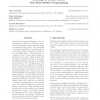Free Online Productivity Tools
i2Speak
i2Symbol
i2OCR
iTex2Img
iWeb2Print
iWeb2Shot
i2Type
iPdf2Split
iPdf2Merge
i2Bopomofo
i2Arabic
i2Style
i2Image
i2PDF
iLatex2Rtf
Sci2ools
122
Voted
ICML
2002
IEEE
2002
IEEE
Learning the Kernel Matrix with Semi-Definite Programming
Kernel-based learning algorithms work by embedding the data into a Euclidean space, and then searching for linear relations among the embedded data points. The embedding is performed implicitly, by specifying the inner products between each pair of points in the embedding space. This information is contained in the so-called kernel matrix, a symmetric and positive definite matrix that encodes the relative positions of all points. Specifying this matrix amounts to specifying the geometry of the embedding space and inducing a notion of similarity in the input space--classical model selection problems in machine learning. In this paper we show how the kernel matrix can be learned from data via Semi-Definite Programming techniques. When applied to a kernel matrix associated with both training and test data this gives a powerful transductive algorithm--using the labelled part of the data one can learn an "optimal" embedding also for the unlabelled part. The induced similarity bet...
Embedding Space | ICML 2002 | Machine Learning | Positive Definite Matrix | So-called Kernel Matrix |
Related Content
| Added | 17 Nov 2009 |
| Updated | 17 Nov 2009 |
| Type | Conference |
| Year | 2002 |
| Where | ICML |
| Authors | Gert R. G. Lanckriet, Nello Cristianini, Peter L. Bartlett, Laurent El Ghaoui, Michael I. Jordan |
Comments (0)

